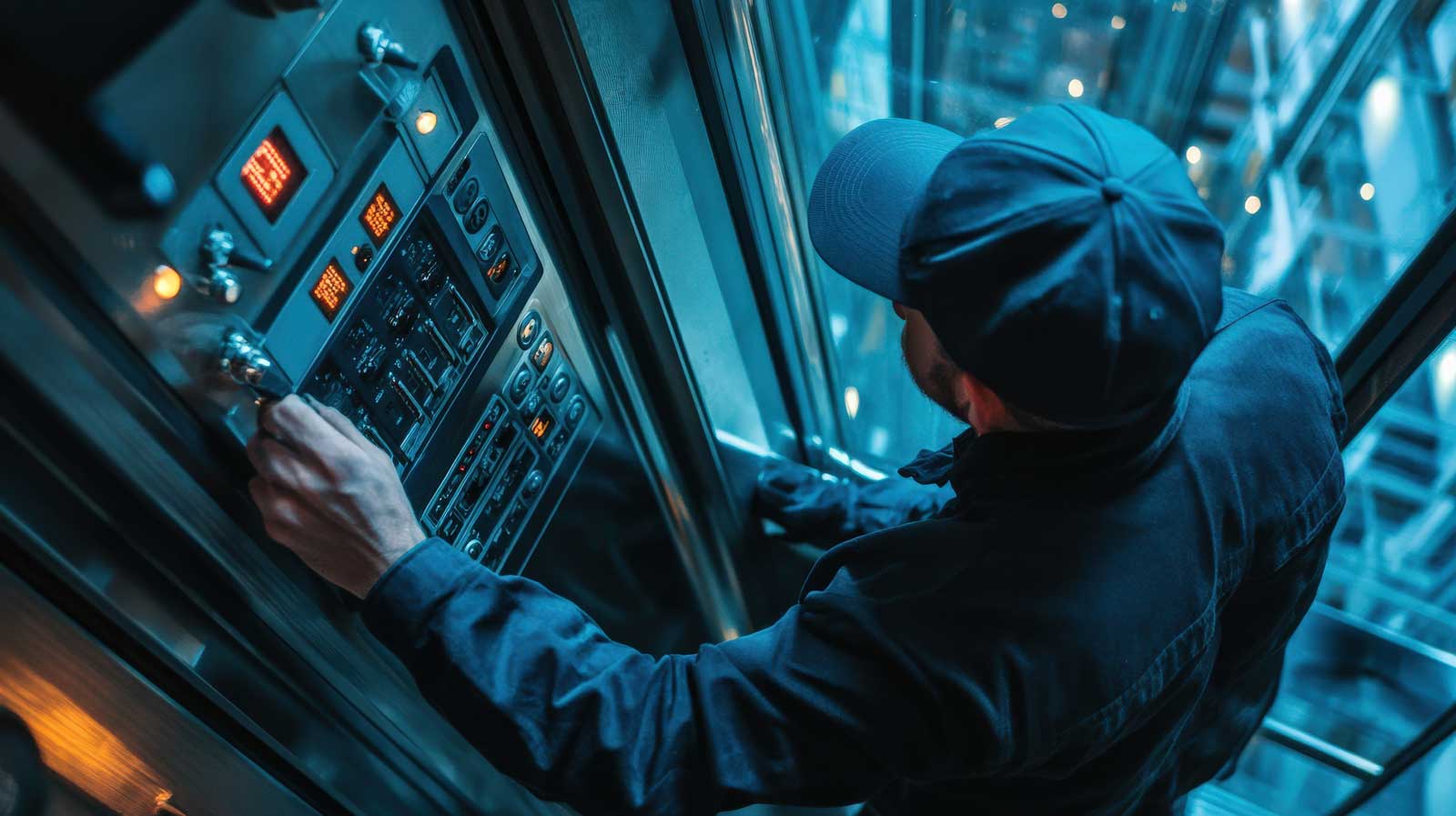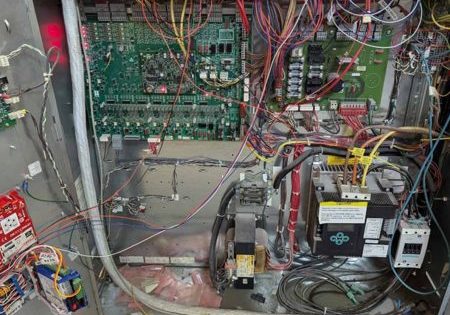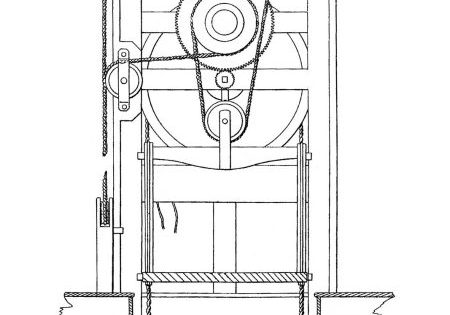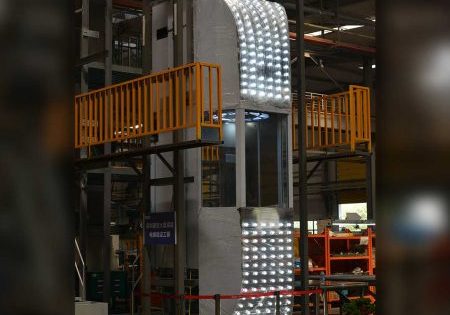Part one provides a view of the details and intentions of this opportunity for change and improvement in periodic testing of traction elevators to ensure safe operation.
Value: 1 contact hour (0.1 CEU)
EW Continuing
Education is currently approved in the following states: AL, AR CO, FL, GA, IL, IN, KY, MD, MO, MS, MT, NJ, OK, PA, UT, VA, VT, WA, WI and WV | Canadian Province of BC & ON. Please check for specific course verification of approval at Elevator Books.
Learning Objectives
After reading this article, you should have learned about:
- With thousands of Category-5 tests with alternative (electronic) testing, this process is better than the long-standing “observation” only method using weights/carts.
- Electronic Category 5 testing (and weighing/validating elevator system masses) is safer, as heavy weights are not needed for periodic testing. The method also reduces the chances that testing causes damage to the elevator and to customer/building property.
- Code language establishing electronic testing included requirements to meet a complete set of demanding technical requirements for any new tool/testing method to be introduced. Adding it as an “alternative” helped those who are reluctant and slow about change.
- Available new methods for electronic Category 5 testing were NOT developed by contractors.
- Testing methods now available accurately account for kinetic forces (energy) in an elevator more directly than a rudimentary test with load could ever do.
A big change in how we can (or should) periodically test traction elevators for safe operation has been in the Safety Code for Elevators and Escalators since the 2013 Edition. This change permits, with constraints, alternative methods for conducting periodic (five-year) testing. Experience with one system has produced inarguable concerns that the established method of Category 5 testing done with full loads is NOT assuring safe elevators in the way we think (or hope). The change has been accepted in some areas of North America and is still gaining acceptance in others.
Change can be a slow process — the fact that many of us resist change is part of the story. Another part of acceptance is “how” the change was added into the Safety Code. How it was done created some specific reasons why this change is evolving. Reviewing the discussion and details about concerns will frame the discussion and should add to understanding and progress.
The “how” is about the way this change was introduced in the Code. That process is detailed in the sidebar. Let’s focus on the issues and questions that have been addressed in a healthy process of discovery and gaining acceptance.
A look at what we have seen in the last 10 years with available electronic tool systems for Category 5 testing reveals a first concern for some AHJs, which was not a surprise. Talking to some chiefs of elevator AHJs, we heard comments about just being old school, and some reluctance to force a change into “their area” until this new method is proven and established. We understand that some AHJs simply don’t want to be the first to accept. For sure, it’s easier to follow than lead the market.
The fact that this has been introduced as an alternative contributes to it being misunderstood. As an alternative, it is something that contractors can choose and try on an individual process basis and on individual elevators according to their readiness. Some of a contractor’s service portfolio can be handled easily using the alternative method, while others in the portfolio may continue to use full-load testing. Both the old method and the electronic method are permitted by the Standard. The AHJ is not forcing the change; it is up to contractors to choose or not, and it does not have to be an across-the-board (analog) approach. Contractors can consider and process the value of adding new capital equipment (tools) according to their own interest and ability. They have time to invest into the equipment, training and learning the process. In areas where electronic Category 5 testing is being used, it has been a positive learning process. The ability to monitor the wear of an elevator’s stopping devices by comparing values of first tests with subsequent tests is seen as a big advantage at the outset. This also goes to satisfying the idea of a baseline in the requirements.
Users find that the new testing equipment opens doors of improvement in maintenance with respect to having statistically correct system masses and to improvement opportunities with elevator suspension means (ropes or belts) equalization/balancing. Performance can be improved, and other maintenance needs and costs professionally addressed. Learning about and using technology enhances overall elevator maintenance and repairs and further challenges skilled elevator technicians in our industry.
This evolution in the Category 5 testing process is not something developed by elevator contractors. There is no need for an AHJ to be concerned that the process may favor certain equipment or that any contractor has an advantage. The current leading electronic Category 5 testing system (ELVI 2) has been evaluated by an independent, third-party elevator engineering company (Liftinstituut). It has been certified compliant with all the testing requirements in the A17.1 Standard. A question of compliance related to “baseline” comparisons has also been addressed in a separate A17.7 Certification of Performance. Having a third party, authorized elevator certifying organization (AECO) is a recognized process within ASME A17 Standards.
Testing algorithms accurately measure elevator system stopping forces, and in the case of ELVI 2, they are set to be at minus 0 and +5% on the safe side. This ensures safety and points repair work to the preferred side of being safe. Electronic testing methods also show stopping performance across the full range of loads where unexpected stops can occur — from an empty car all the way to stopping with rated load. We know that emergency stops are as likely to occur with one or two passengers on board as they are to occur with a full load of passengers.
The biggest positive of electronic testing, which we know is of particular interest to AHJs, is an output of results in discrete numbers documented in a complete, professional, readable, accurate and reliable report. Numbers show a relative position of test result; this is far better than any checklist can ever be. Important and demanding requirements were added for this new method in the Standard. Any new tool is required to be based on sound engineering principles that are documented, validated and proven capable of producing reliable and consistent measurements. Monitoring and calibration are required and assured. Tests are conducted, results are evaluated and included in an official printed test report in a pdf format, which, in turn, is part of the Maintenance Control Program (MCP). In discussion with mechanics and technicians, it has been noted that the detail in this report is the best possible proof that testing was properly and correctly completed. All tests are in a final date- and time-stamped report. When tests are done incorrectly, the system will report “Error” and not be capable of reporting a pass (or fail). The bottom line of this is if there ever is a question about testing, the data and report clearly support that the work was done, and the results show a current state. If there is ever a problem, the technician/mechanic has proof and back-up for their work.
With electronic testing, weights are not necessary for any periodic testing (including Category 5, of course). Full load tests continue to be done for acceptance of a new installation or a modernization. We are assured this will remain in the Standard. For initial testing (acceptance), we will always want to know that the elevator has been subjected to the most rigorous testing. It is at this point that some overload and overspeed is done. All of this assures the system design and equipment was correct, and we expect the elevator final assembly was solid.
During training, we point out that electronic testing can be used for assuring set up, adjustment and potentially knowing the elevator is ready for its rated-load Acceptance Test. Confidence is higher that it will pass acceptance when electronic tests are used for set-up. During adjustment, we can perform safety tests at less than rated speed and no-load. The method and the algorithms work, even in the case of a safety stop (provided we know there was enough speed to get a full action [set] of the safeties). It has been suggested that, for the highest speed elevators, a safety stop at 300 ft/min is enough for a full actuation of the safeties. Preparatory tests with electronic equipment can position us so only one round of load testing needs to be done — on the day of acceptance. This helps to preserve key components by not subjecting them to undue wear and tear. Further, with respect to high-rise/high-speed elevators, the five-year safety test could be done at something like a maximum of 300 ft/min (1.5 m/s). The Code would have to be changed to allow this — recognizing that rated speed tests are not necessary.
This improvement in testing also reduces the risk of injury to elevator employees. We could have mentioned this first. With weight carts out of the picture for Category 5 testing, we minimize the need to move heavy weight carts. This is a big opportunity to decrease back and hand injuries from moving weight around.
We also reduce chances for damage to customer property — the chance of weight carts hitting entrances and walls and damaging floors is only an issue at Acceptance. The wear effect of testing (and preparing for testing) may also be reduced. No weight carts also brings in the cost of logistics — time and fuel for delivery of carts to a site. Elevator technicians can focus their time on meaningful and needed elevator maintenance instead of repairs caused by full-load testing. We don’t have to try to break or almost break parts (unknowingly) to assure ourselves that our key stopping devices are working. Seems like a silly thought; but it is a fact of life doing rudimentary weight tests.
In the sidebar detailing what is included in the new Code, your author talks about the fact that weighing cars and counterweights (knowing system masses) is a very apt addition to periodic testing. It was never officially included in the Safety Standard, likely because the North American Code focuses carefully on being non-prescriptive. Experience has shown that elevator weights (masses) are often different from original (crosshead dataplate), and this important fact is not documented. This is a potentially dangerous situation. We covered the importance of knowing masses in another article: Elevator System Weights – A Critical Mass (ELEVATOR WORLD, February 2024). Note here that there is another “new” addition requiring a Percent Counterweight Overbalance Data Plate in ASME A17.1-2019/CSA B44-19. Code and safety can be improved.
With respect to the huge advantage that electronic testing is numerical and discerning, when we perform weight tests, we have no possible chance of knowing if a test just caused our stopping force to be compromised, and it may not do what’s needed next time. It’s also possible to measure a pass on brakes because the counterweight is too heavy compared to the car (and the brakes themselves are not where they need to be). Simple observation in load testing brings us little information and no documentation that a test was either a clear pass or was very close to failure.
Testing using loads has served us well. It has given us some assurance, as noted, for more than a century, beginning in the first Safety Code for Elevators in 1921. It relied upon a useful table with basic velocity and mass parameters. Elevator system engineers who continued to support that method contributed to developing the alternative testing concept. Code can evolve based on technical experience which, in turn, improves elevator safety — all on a foundation of better maintenance.
We now know that some things in the old method are not as reliable and as consistent as we thought they were. One thing, covered with emphasis in the new method, is verifying system masses. If the masses we “knew” were inaccurate or approximate, how consistently correct was the method using the table? Was testing at rated speed necessarily validated?
Stopping distances vary (based on other system factors like rope design) and are not always in alignment with the established estimates in those tables. System mechanical, environmental and test-process variations can yield unreliable and potentially unsafe results. Fortunately, in the world of elevators, we have redundancy in stopping safety, so those effects so far have likely been covered for us by redundancy. We know from a Code Inquiry made in 1987 that a secondary stopping device could have been acting and contributing to full-load test stop. In a bit of a surprise, the Standards committee allowed that, apparently satisfied that elevators have redundant back up. Alternative testing goes further and does not allow this — the test on each device MUST be isolated to the device being measured. Existing electronic testing will not allow a test that is not isolated. The software will see it as an error in testing, and it will need to be repeated until a valid test is completed.
Further, with load testing, exactly where a safeties stop is initiated in the down run has a direct effect on stopping distances. The weight of the counterweight and rope length on either side causes a lesser or greater spring effect. We have found that the original table hypothesis that the counterweight is airborne (and there is no effect) is not supported in electronic testing roughly 75% of the time. This now-known fact directly and inconsistently affects the stopping forces of safeties, brakes and the buffer. Differences in rope constructions also affect slide and stopping distances. Differences like these are not discernible in full load tests but are accounted for in electronic testing. Something else that is unique to the Henning ELVI 2 system is that its measure of safety stopping forces can tell us with accuracy if the tested elevator’s safeties can deal with the worst-case scenario: whether the safeties can stop a car that is free-falling because it has completely lost suspension means.
Our industry is fortunate to have technicians who think about their work, ask questions and demand answers and explanation. Over the years of talking about the new testing method and training a few hundred technicians so far, we have had some interesting questions and discussion about the old method and about the new way.
We have already noted that doing initial acceptance testing with rated loads is still required by the Elevator Safety Standard. Reducing a broad dependence on test weights will decrease repairs caused by the wear-effect of testing (or preparing for testing). There are some instances where weights are needed during maintenance and evaluating the capability and performance of key system components. One of those is the Power Drive unit. As a maintenance procedure, this is sometimes done to prove whether the drive has lost its ability to convert power to running the motor efficiently when moving an operating elevator with load. When there is concern about the drive function, weight is added gradually, as having the loaded elevator set down on the buffer may cause an additional maintenance challenge — getting the weight out so the car can be lifted off the buffer. We had this question asked during a technical presentation about electronic Category 5 Testing a few years ago. Our answer to this is that evaluating drive function is a normal maintenance activity. We think it makes sense to not expect that we will wait and discover there is a drive issue as part of Category 5 testing. Periodic testing was not devised for that purpose. If maintenance relies on this, it may be discovered too late, waiting for the next five-year test or having it happen during the Category 5 and then facing the challenge of having to remove weight from the car. That process is time-consuming and has some related functional safety issues. Better to approach it with care and forethought rather than having it surprise us at Category 5 testing.
In another recent surprise related to an existing broad “dependence” on test weights, there was a misinformed suggestion that rated load is needed to test limit switches. We had one AHJ question that ETSL (emergency terminal stop limit) switches seem to be required to be tested with weights. We had to discuss and answer questions about language in another document [ASME A17.2-2020 (revision of A17-2-2017) Guide for Inspection of Elevators, Escalators and Moving Walks]. This document is a guide that includes inspection procedures for electric traction elevators. In most jurisdictions, this guide is understood to be a guide and is not considered part of the Code. We also explained, after a careful read, that references to putting load on the car were oblique and actually fell under a section talking about testing oil buffers (which is directly included in the Alternative Testing sections). It seems that the language in the A17.2 guide needs to be brought in line with this current development. Last, we could not find an engineer who would agree that load on an elevator car will have any effect on whether a mechanical switch is actuated.
Very recently there was a repeated question suggesting concern about the fact there is kinetic energy involved whenever a stop is executed. The idea, we think, behind this question was that kinetic energy and momentum with a fully-loaded car creates a greater challenge for stopping than we would have with an empty car. According to physics (Newton’s Second Law of Motion) the stopping force is always the same. Again, F = ma where force equals mass times acceleration. When mass varies (from no-load to rated full load), the result is a longer distance to stop; though always the stopping force remains the same.
With kinetic force the principle is very similar with algorithm variations needing to go to Force (Energy) times distance (E = F*d). When there is more kinetic energy, the stopping distance will be longer. Kinetic force relates to the Law of Conservation of energy. Algorithms using physics and engineering are necessary and integral to understand stopping forces; the needed energy for stopping a car is higher as the speed increases. There is certainly some related discussion to be had about heat generated by brakes, safeties or absorbed energy in a buffer. The testing algorithms must, of course, take these into account. We can be comfortable that, in the relatively shorter stopping distances in the down direction of an elevator (at rated speed or overspeed), the amount of heat generated likely does not have a large effect on the stopping force. At the end of the day, rest assured that newly developed systems must carefully and correctly take physics into account.
In the last century, we have put a lot of faith in the observed stopping of an elevator with weight and came to believe that this can only be tested and confirmed by a rated speed plus rated load test. In reality, after testing, our observation of the testing results (the slide) is limited, and precision is, at best, an approximation. With measured tests (even with an empty car) and the correct algorithms, we have a degree of accuracy and precision we can never have when making a simple visual observation. We thank thoughtful and questioning technicians in the Midwest and Chicago area where questions like these have been brought up.
We are hopeful that we have achieved our goal of presenting here a complete (exhaustive?) view of the details and intentions of this opportunity for change and improvement in periodic testing. This was our goal for Part One. Part Two, coming in a later issue, will give a complete and graphical training on all the elements of completed electronic Category 5 testing of traction elevators. When you see what’s included, you will also know that this testing does its job and leads us further in the direction of better maintenance and safer elevators.
Code Process
It has been more than 10 years since electronic Category 5 testing was introduced in ASME A17.1-2013/CSA B44-13. We know that adopting change in the elevator industry is a slow process. It’s human nature to resist or at least question change. It’s our experience that a significant reason this change has been slow and tentative is related to how it was written into the Standard. It started with a new section 8.6.11.10 titled Category 5 Tests Without Load Via Alternative Test Methodologies. The first section (8.6.11.10.1) was titled Where Permitted and the following language said “permitted…subject to the approval of the authority having jurisdiction.” We have something around 100 AHJs in North America.
Foresighted elevator engineers knew that technology for better measurement methods already existed for testing and verifying stopping forces. They also knew that change to allow electronic testing would not come easily. Adding weights (hand weights or weight carts) was the traditional practice; it was entrenched and is still held onto as necessary by some. There are those who haven’t had the physics and engineering explained to them (yet), those who resist change or even those who believe they are preserving work for elevator industry labor. It seems that even though the Code writers saw opportunities for change, they knew there would be questions and they knew time would be needed for AHJ acceptance. They were not willing to force it. They knew the market should do that. And whoever designed, and successfully introduced, alternative (electronic) testing methods would need to have patience and drive the process of gaining acceptance within the industry and the AHJ community.
There is now more than a decade of experience, and there have been opportunities in the industry to debate the acceptance of alternative testing. For better understanding, we’ll discuss the idea, the process and its development and focus here on how this change was added to our Safety Code.
The requirements of load testing first came into the elevator industry in “A Code of Safety Standards for the Construction, Operation and Maintenance of Elevators, Dumbwaiters and Escalators” (predecessor to A17.1/B44) in 1921 (Rule 206-Car Safety Tests. a — A rated capacity test. Under the supervision of a designated authority shall be made of every new elevator before the elevator is placed in regular service). At that time, putting loads on elevators to assess main safety-related components like brakes, safeties, traction and buffers seemed to be the only way to physically assure the needed stopping forces were operational in traction elevators.
Elevator engineers understood that stopping forces needed to be within a range where stopping should not cause injury to riding passengers. In 1921, Rule 205 Car-Safeties and Speed Governors limited the safety stopping distance for an elevator carrying its rated load, traveling at rated speed to between a minimum and maximum slide distance which, in turn, generally assures that the stopping force measured relative to the acceleration of gravity (g) measured in ft/s2 or m/s2 is above 0.35 g and below 1 g. This set the boundaries for safely stopping human passengers during a safety application. Stopping force requirements and tables in current and long-existing Codes and Standards remain in this accepted range (see Table 2.17.3 in ASME A17.1/CSA B44 for Acceptance Tests at governor overspeed and a corresponding Table 2.29.2(b) in ASME A17.2/CSAB44 for Category 5 testing).
Our evolving periodic testing standards continue with the same exact requirements within Alternative Testing. There is no variation from that principle in this idea of improving testing. The requirements are clear and measured more precisely with new testing methods. The aim of this article is not to cover all the technical requirements of the Elevator Safety Code. It is useful for us to explain the changes and show that they were not intended to be easy or taken lightly.
We know from discussions and the memory of participants that ASME A17 Code Committees began debating in the mid-1990s how to improve testing of elevators. They focused on ensuring safe operational ability and meeting already proven important and basic safe stopping requirements. It is clear, looking back, that key people in the elevator engineering community had an idea that testing elevators by just adding loads was rudimentary, had shortcomings and could be improved. Code committee engineers, including George Gibson and others, knew better methods existed but it was not their role to prescriptively define how any new testing system would work exactly.
With ASME A17.1-2013/CSA B44-13, the idea of alternative testing officially got into The Code. In our discussions, we will variously refer to it as electronic testing, as we believe that gives us a more apt comparison and basic understanding between the old way of testing and the new method.
It took some years of debate, discussion and consideration to get to what was new in 2013. It should not come as a surprise that ideas, some detail and direction for an improved testing method were part of the new language. It is helpful that we point out examples of that guidance:
- Requirement 8.6.11.10.1 covered, as mentioned already, specifically where a new testing method is allowed and to which traction elevator “stopping/safety” devices (within periodic/Category 5 testing) the new testing would apply. The new section specifically designated car safeties; oil buffers; driving machine brakes; braking system, traction and traction limits: and emergency brakes. Also included was a reference NOTE to another section (8.10), which happens to be the lead section for Acceptance Inspections and Tests (also known as “initials”). There are two notes. Notes are not enforceable; they are intended to be informational. The notes say that compliance is verifiable through review of design documents, engineering or type tests AND that any new method requires a comparison against baseline measures made during acceptance inspection tests.
This introductory section was the first reference (maybe a compromising nod toward the existing testing method with load) where the idea of any new method may need to “baseline” against Acceptance tests. It was the rigor of Acceptance Testing where the baseline idea was to be derived. The phrase “correlate no load with full load/no load” comes up again later in 8.6.11.10 and has been considered along with the word “baseline.” The term baseline is used, but not defined, in The Elevator Safety Standard.
- Requirement 8.6.11.10.2 says the new test method “shall be” based on sound engineering principles, confirmed and documented using engineering tests; capable of producing reliable and consistent measurements and that there must be monitoring and calibration of the measuring devices. While not prescribing how new testing should work, the new code provided structure and an engineering foundation.
- In Requirement 8.6.11.10.3 there is a new “need” added to periodic testing (Category 5 here) setting out that verifying car and counterweight masses is required under Alternative Testing. With a basic understanding of physics (Newton’s Second Law of Motion, where F = ma, or Force equals Mass times Acceleration), we see this to be significant. Knowing system masses and accelerations (decelerations) is integral to being able to measure stopping forces (or the energy required to stop the elevator). The principle is that a measured stopping force (on any elevator device) will remain the same even as mass and deceleration (distance) are varied. Industry professionals understand and accept that elevator system masses and the relative balance (between car and counterweight) are also related to the efficiency and performance of applied stopping forces. There is no mention about this in any instructions related to full-load testing. It is assumed, we are sure. Frequent examples have been heard by many of us where loads have been changed on existing elevators and the existing operating balance is different from the originally engineered masses. The rest of this requirement describes that the new method must have a detailed procedure document. Range and limits of use must be included, test set-up procedures documented, instructions on interpreting and correlating results to pass/fail criteria and monitoring and calibration requirements are required. Further, it adds requirements that the new method must detail test procedures for periodic tests, and that they be included in the MCP.
- Requirement 8.6.11.10.4 takes more steps that full-load testing has never required — a quantitative and detailed Test Report. This section requires documenting the tool used (make and model), the company and personnel performing and witnessing the tests, results from a “baseline” that could be used for future comparison, the recorded car and counterweight masses and the pass/fail conclusions. The report must remain “on-site” with the elevator or be available to elevator personnel and the AHJ.
For every applicable device within an existing Traction Elevator that involves stopping forces, Code writers and the Standards Committee were careful to include language in each relevant section referencing that alternative test methods can be used. These sections (8.6.4.20.1; 8.6.4.20.3; 8.6.4.20.4; 8.6.4.20.10; and 8.6.4.20.11) are specifically mentioned in 8.6.11.10.1. The forces evaluated in these requirements for safeties, oil buffers, driving-machine brakes, braking system traction and traction limits, and emergency brakes, respectively, now include the allowance of an alternative method for testing. We can note here that traditional testing is only visual and “documented” by checking a box that the test “appeared” to pass. With electronic testing, we know now that stopping forces are actually measured (in g); we see the actual numbers, and we can see the range of stopping force from no-load up to rated load (or higher). AHJs are pleased to see reports documenting the stopping forces — where one can see if it is close to failure and that follow-up tests can be made annually if there is reason to be concerned. Performance with numbers gives us a discerning view, while a checked off “pass” provides only one data point based on inaccurate visual examination.
We take the time to include here and review the details of this Code testing evolution and development to make it clear that it was written with a great deal of thought and consideration. It is intended to be an improvement. Moving toward better testing (part of inspection and maintenance) was the writers’ goal, and it should always be ours.
Learning-Reinforcement Questions
Use the below learning-reinforcement questions to study for the Continuing Education Assessment Exam available online at Elevator Books or on p. 113 of this issue.
- Is the process of developing and implementing new code too slow? If so, what contributes to that situation?
- What is the biggest advantage of using an electronic testing method compared to an observation-based testing method? Does this advantage lend itself to establishing a baseline for future tests?
- Why is knowing elevator system masses important to alternative/electronic testing methods? How is this information then useful and relevant in other ways to elevator maintenance? This information contributed to the development of another new code requirement. What was that addition to ASME A17.1-2019/CSA B44-19?
- What are some shortcomings of the long-established observation method of testing traction, elevator brakes, safeties and buffers? Did alternative methods help to reveal them, and did they bring another level of understanding?
- Does alternative testing mean that full-load testing goes away? When does it make sense to bring weights to test, adjust and do maintenance on a traction elevator?
Get more of Elevator World. Sign up for our free e-newsletter.










